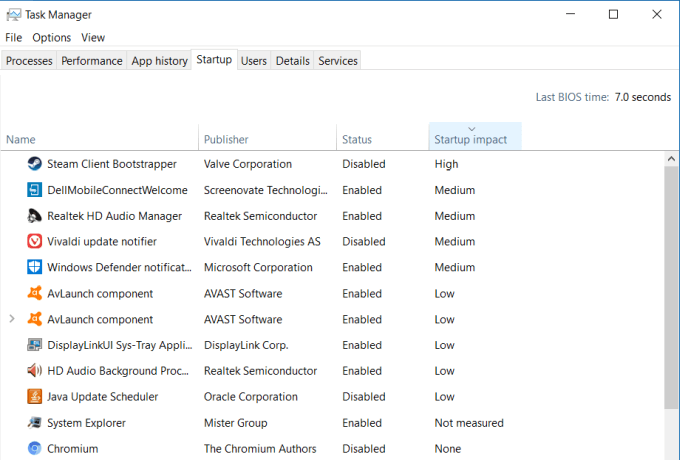It can be one of the most annoying problems with Windows – you’re happily browsing the web or working on a document and suddenly up pops the “low-memory warning”.
- Clean Memory Windows 10
- How To Clean Laptop Memory Windows 7 Download
- How To Clean Laptop Memory
- How To Clean Windows 10 Computer
- New Laptop Clean Windows 10
- Wipe Clean Windows 7 Laptop
The best way to clear your memory is by restarting your computer. Check your Task Manager The best way to clear your memory is by making sure that no application is consuming your entire RAM memory. You don’t need to guess which app is using your RAM. Welcome to Windows 7 Forums. Our forum is dedicated to helping you find support and solutions for any problems regarding your Windows 7 PC be it Dell, HP, Acer, Asus or a custom build. We also provide an extensive Windows 7 tutorial section that covers a wide range of tips and tricks.
Find out what causes this problem and how to fix it.
Low memory warnings happen when Windows has run out of space to put the data it needs to store when you’re running different applications. This can be either in the RAM modules in your computer, or also on the hard disk, when the free RAM has been filled up.
Typically if you’re getting these warnings, something has gone wrong with the paging file that uses your hard disk for extra storage.
You can check this by opening the Performance tab of Windows Task Manager (press the Ctrl-Alt-Del keys simultaneously).
The page file is almost full – not good!
If your page file usage is almost full, and the Free memory is low, then Windows is running out of memory for your running applications.
This can cause things like web browser crashes, other program crashes etc.
How to fix it
- First, check that you have enough free disk space.You can usually do this by clicking on Computer from the Start Menu, and then looking at the free space value to the right of Local Disk.
If this is lower than a few hundred MB, then you need to free up space on the disk by deleting files, and then emptying the recycle bin. This will free up disk space for the paging file to use. - Your page file may be switched to manual instead of automatic control, and set to too low a value.
Check this by right-clicking on Computer and selecting Properties. You should get the system panel displayed similar to this: - Click on “Advanced system settings”, then the Settings tab under Performance at the top.
- The “Performance options” page will open. Click on the “Advanced” tab.
- Now click on the “Change” button under “Virtual memory”.
- You will see the Virtual Memory options page. This controls the size of the paging file.
Usually you can tick the top checkbox for “Automatically manage paging size..” and Windows will handle everything itself, as long as you have enough free disk space.
However, you can keep this checked off if you have reasonable values set here.
What are reasonable values here?
See below..
Paging File – Manual settings
Most of the time, you won’t need to use manual settings for virtual memory. However, there are some outlying cases where it might be useful.
One of these might be where you have a limited amount of disk space, and don’t want the available free space to be increasing and decreasing all the time as Windows adjusts the size of the paging file.

Considerations when modifing virtual memory settings:
- Unless you have a lot of memory (at least 8GB) and are using a 64-bit version of Windows, then you should have at least one disk set to use a paging file. This will typically be the C: drive.
- You don’t necessarily need to set a paging file on more than one disk, although it’s possible.
- Recommended minimum size is 512MB for compatibility reasons.
- The Maximum size is a matter of preference, and depends on how many applications you run at the same time, but it’s probably better to set it to at least 4096MB (4 Gig) or higher.
- Using both a SSD and standard hard drive in the same computer?
Moving the paging file to the SSD disk can greatly speed up your system, since page file access can be one of the most frequent reasons for read and write usage of the disk.
This is especially true if you don’t have that much physical RAM installed, or your disk light is frequently lighting up due to disk page file swapping.
There was some concern with earlier SSDs that putting such a highly-used file on the SSD would lead to a shorter lifespan for the solid-state disk, however this is unlikely to be a concern for newer SSDs and the performance boost could be significant.


Has it worked?
Once you’ve either freed up disk space or adjusted your page file settings, you can start the Task Manager again to see what’s happening.
Note that you might have to reboot your computer before doing this if you have changed the virtual memory settings.
Try to start using something that uses up memory, such as a web browser session with a lot of open tabs. If it appears that your page file space is not being exhausted, and you don’t get any popup error messages, then the problem is solved.
To prevent low-memory problems reoccurring, make sure to try to free up enough space on your disk if it’s running low.
Random access memory, or RAM, is the short-term or operating memory on your personal computer, and it is accountable for how the PC runs. As you continue to use your Windows PC, the available RAM (Random Access Memory) decreases. This happens as you install new programs, download applications, keep some unused files or create new files. Over time, your computer begins to slow down. Programs take longer time to launch and in the worst scenarios your computer runs into errors.
Such slow-running PCs are frustrating, and misused RAM is a key culprit why computers become sluggish. With a few simple troubleshooting steps and guidelines, you can free up RAM space and improve your computer's performance. Read below to know such steps:
Uninstall the installed Programs
Clean Memory Windows 10
The RAM decreases as you install new programs on your computer; the more you install the programs the slower it will become. For everything appears on your computer takes up a certain amount of system resources. Over time, your computer gets more and more slowly, the boot time extends, and all programs take longer to launch. Hence, to get rid of this, just uninstall all the programs that are not needed keep only the required programs.
For this just follow the below steps:
- Click Windows Start button -> Control Panel -> Locate the programs you are no longer use -> Double-click Add or Remove Programs-> follow the instructions to uninstall the programs.
- After this just remove the delete the setup files of those uninstalled programs For this go to Start -> Program Files -> locate the uninstalled programs just delete them and empty the recycle bin.
Uninstall invalid and corrupt registry entries
Installing new applications will create new registry entries, even after uninstalling the programs will not remove its registries; they might remain where they've been stored. Over time, your computer will turn into mess. So remember to cleanup registry entries when you uninstall a program.
Click Windows Start button -> Click Run ->Type- regedit -> press enter to launch the Registry Editor -> Locate the uninstalled application -> Right-click on it and select Delete
How To Clean Laptop Memory Windows 7 Download
Clear Windows Cache (Internet files)
As you open new site or pages on your internet browser, the address and other login information will be saved in a temporary files and Browser history to facilitate easy access when you need it the next time. However, this would even lead to unnecessary cache memory and hence needs to be removed.
- In control Panel, locate the Internet Options icon Double-click on it. Under “Temporary Internet Files” click Delete files and then “OK” to confirm. Once all files have been deleted, exit Control Panel.
- Open the browser, click on the Settings option and select History and now just select “Clear Browsing History” this will remove all the history and even free up the cache
- Click the “Start” button -> enter .tmp in the search field. You will find a list of temp files, browse through them and delete all unnecessary .tmp files.
How To Clean Laptop Memory
Clear Junk files, temporary desktop files, log files etc...
How To Clean Windows 10 Computer
As and when you use your system, your RAM memory will filled with some unused old files and other junk files. Hence one has to get rid of such files. For this you can use the Windows default tool called “Disk Cleanup”. Follow the steps mentioned below:
New Laptop Clean Windows 10
- Go to Start -> Programs -> Accessories -> System Tools ->Disk Cleanup
- Under Disk Cleanup tab and you will find many categories check on the following: Temporary Internet Files, Recycle Bin, Temporary Remote Desktop Files, Offline Files, Temporary Files, Compress Old Files and Setup Log Files.
- Now click the “More Options” tab and under “System Restore” hit the “Cleanup” button. (It removes all the System Restore points except the most recent one)
- Click the Disk Cleanup and click OK
Wipe Clean Windows 7 Laptop
This will delete all the unnecessary files on your Windows system and free up your RAM. Now your PC is free from unwanted programs and files, thus increases PC performance. Didn't you feel this as a lengthy procedure and requires extra care and time. Instead you can just make use of the Remo Privacy Cleaner software that will do this for you in just one single click. This tool can quickly uninstalls all the programs, removes internet cache and temporary files, erases the junk files, log files etc. Thus with one tool you can perform all the above steps in just a single click.
